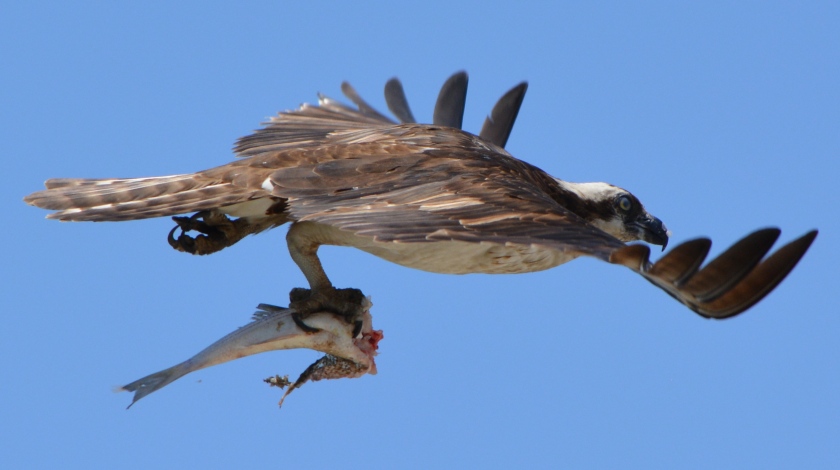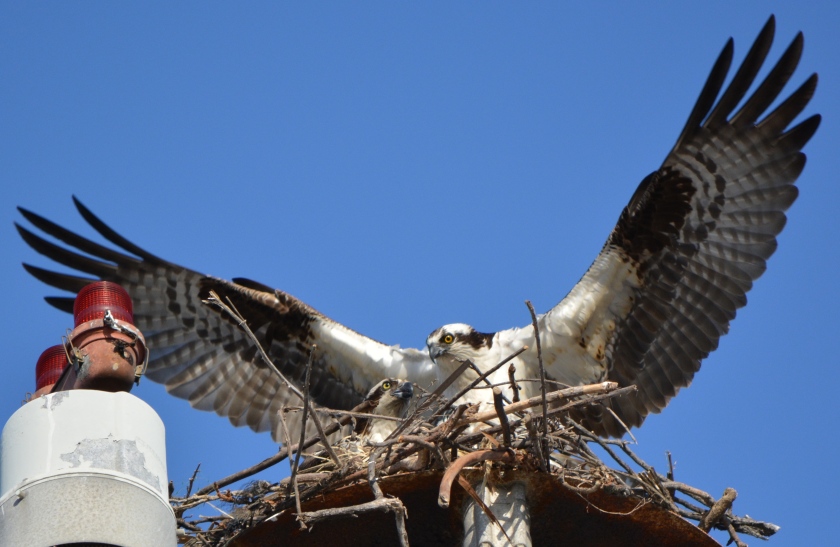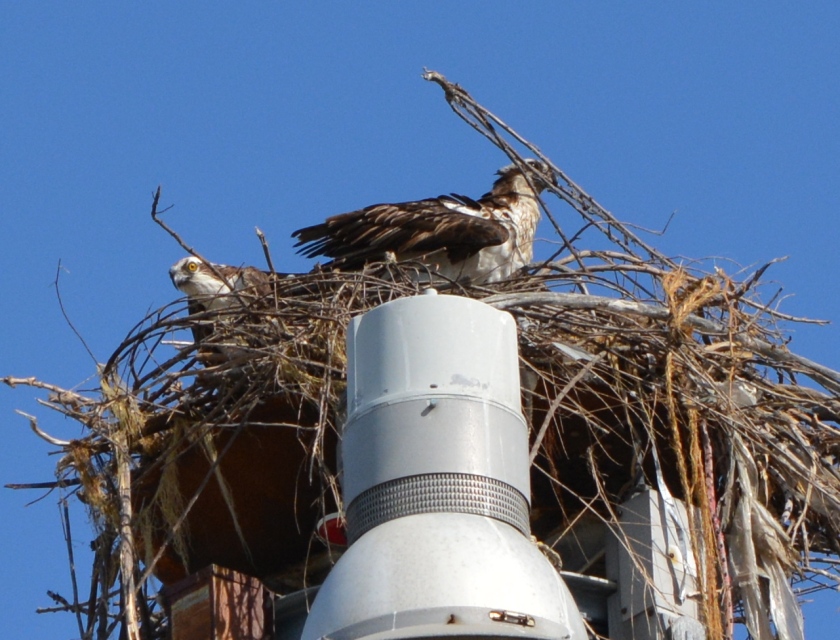In early June a pair of returning ospreys looked ready for the day in their newly made nest atop a parking lot light pole at Alameda Point, but they had no chicks to attend to. The pair’s first nest this season — on a nearby ship — had been removed during construction. Their second attempt faced interference from another osprey. By June, hopes for fledglings this year had faded. An ad hoc group of osprey watchers is hoping a dedicated osprey platform can be erected at Alameda Point in a spot where competing interests and annoyances of daily commotion don’t intrude into the reproductive efforts of the ospreys.

In early March the osprey pair began building their first nest this year where they had nested last year — on a kingpost high atop the maritime ship Admiral Callaghan. The ship’s owner, the Maritime Administration (MARAD), had removed last year’s nest. This year MARAD moved quickly to stop the nest building to avoid potential delay to relocate a nest if ordered into service. “The Maritime Administration worked closely with the California Department of Fish and Wildlife on dismantling the nest and installing deterrence devices on March 19 prior to any eggs being laid,” said Alameda resident Harvey Wilson, who has been monitoring the ospreys at Alameda Point.

But that removal didn’t end the ospreys’ interest in the ship, at least not for the male osprey. He soon started bringing sticks to a lower-level hoisting post on the ship. The female, on the other hand, took a liking to a light pole in the parking lot next to the wharf. After weeks of back and forth episodes of mating and nest building at both sites, the female won, and nest building started ramping up on the light pole. At one point, it appeared that the female was hunkering down in the nest, a sign that eggs had been laid and incubation had started. But soon another female osprey appeared, trying to lure the male from his duties and disturbing the composure of the female.

The third osprey now seems to have moved on, and the original pair has continued to visit the nest, but the lateness of the season offers little hope that eggs will be laid again, if they ever were, this year.

The appearance of ospreys at Alameda Point, first documented in 2010, is part of larger Bay Area phenomenon of ospreys beginning to nest on the shores of San Francisco Bay. Osprey first began nesting in the San Francisco Bay Area in the year 2000, having moved their nesting range further south. There are currently 24 active nests on San Francisco Bay. One theory for the ospreys’ Bayside nesting interest is a reduction of silt in the Bay, making it easier for osprey to catch fish, their primary food source. The high silt levels are a legacy of the gold mining era during which streambeds emptying into the Sacramento River were blasted with water canons to expose gold particles. Ospreys normally return to the same nest every year, but the Alameda Point pair has now used three different sites. In 2012 they successfully raised their lone chick on an old light stand on the western jetty of the Seaplane Lagoon, their regular nest for three years. For unknown reasons, they chose the heights of a maritime ship in 2013, and in 2014 a parking lot light pole.

An ad hoc group of osprey watchers that includes members of the Golden Gate Audubon Society have been discussing with the city the possibility of erecting a permanent osprey nesting platform on the western side of the Seaplane Lagoon. “City staff has been and is willing to continue to work with interested members of the local community to potentially establish an osprey platform at Alameda Point,” said Jennifer Ott, Chief Operating Officer for Alameda Point. “The identification of an appropriate location for this platform will depend on a number of factors, including approval by the United States Fish and Wildlife Service.” In March of this year, the city of Richmond’s Public Works Department assisted with the installation of an osprey platform at Pt. Molate, which helped divert nesting efforts from a utility pole with live wires. PG&E, with extensive raptor nesting diversion experience throughout California, has offered to install a pole and nesting tub at Alameda Point for free.

“It is difficult to know what the ospreys feel or how they respond or what their capacity is for all the activity that goes on around them, but this season certainly challenged them,” said Alameda wildlife biologist Leora Feeney. “Providing safe platforms for them out of busy corridors would serve everyone better.”

Published on the Golden Gate Audubon Society’s blog Golden Gate Birder.
See also:
- “Ospreys’ nesting effort draws competition atop maritime ship” on Alameda Point Environmental Report.
- “Young osprey at Alameda Point leaving soon” on Alameda Point Environmental Report.
- “Ospreys take a liking to San Francisco Bay” in Bay Nature.
- “Pt. Molate — Where Osprey Come To Nest” on Citizens for a Sustainable Point Molate website.
- PG&E’s “Protecting Birds” page.

































1-9-2015 Today my husband, a neighbor and I rescued an osprey that had become entangled in fishing line which included a sinker, float and 10″inch fish still on the hook. We live at 451 Cola Ballena, Alameda. We have a video we can send if you provide a link. I literally swept him over to the dock with a broom and then we put a small fishing net over his head so I could lift him out of the water. Then we put him in a box and snipped all the fishing line off him. When we removed the net, he sat up, watched and chirped a bit, panted a bit, shivered a little, then began airing out his wings, fluffing himself up and resting. We left him alone on the dock and after about 30 minutes, he took off, circled around our condos, then flew off toward Alameda Point.
LikeLike
Lou Ann, Thank you for the alert and your timely assistance to the osprey. This was probably the same osprey that the Golden Gate Audubon Society has been monitoring for several months. It had been spotted with fishing line wrapped around its chest with a small knotted tail of line. Audubon was unable to trap the osprey and remove the line. Sounds like life for the osprey got worse with snagging a line that included a sinker. Yes, please send me the video. You can upload it to my file sharing site here: https://www.hightail.com/u/AlamedaPtEnviro No log in is necessary.
Thanks,
Richard
LikeLike
Lou Ann, You have done an amazing heroic thing to help this bird in a desperate situation! I am the Executive Direcor of Golden Gate Audubon. Please contact me: cmargulis@goldengateaudubon.org
I am eager to see your video and meet you to thank you, personally, for your compassion and bravery in rescuing this bird! We believe this is the sole breeding female osprey, and hope to confirm by reviewing your video footage. SO GRATEFUL for what you’ve done!
LikeLike
This morning (4/29/2015), we saw a pair of ospreys headed out toward the ships, one carrying a bare bush that was about 3 feet long and 2 feet in diameter. Let’s hope they have more luck this year!
LikeLike